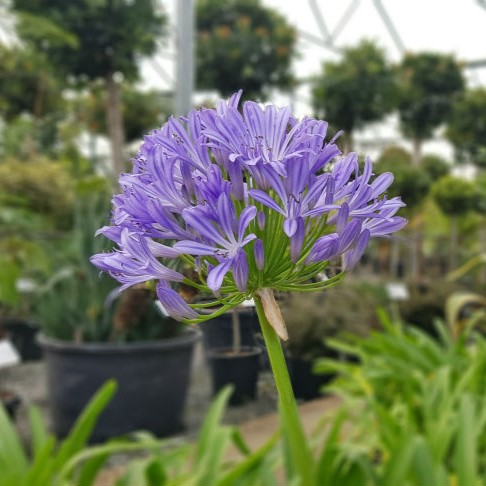Letting Loose the Secret to Effective Agapanthus Cultivation: Idea for a Flourishing Yard
In the world of horticulture, cultivating agapanthus successfully requires a tactical method that encompasses numerous aspects of plant care. With careful focus to information, one can open the tricks to nurturing these stunning blossoms, bring about a yard that prospers with charm and vibrancy. By comprehending the subtleties of agapanthus growing, one can produce an atmosphere where these plants flourish and flower abundantly. In the adhering to conversation, we will check out important pointers and techniques that will certainly assist you towards a flourishing agapanthus yard, supplying insights right into finest practices, dirt problems, watering techniques, and more.
Growing Agapanthus: Best Practices
When growing Agapanthus, correct soil prep work is crucial for guaranteeing effective growth and advancement of these gorgeous blossoms. Agapanthus, frequently referred to as Lily of the Nile or African lily, grows in well-draining soil with a somewhat acidic to neutral pH degree - Agapanthus. Before growing, it is important to amend heavy clay dirts with organic issue such as compost or peat moss to improve drain and provide crucial nutrients for the plants
To grow Agapanthus, choose an area that receives complete sunshine to partial shade, as this will certainly promote healthy development and bountiful blooming. Dig a hole two times the size of the plant's root sphere and position the Agapanthus at the very same depth it was previously expanding. Delicately backfill the hole with soil, pushing down firmly to eliminate any kind of air pockets around the roots.
Water the recently grown Agapanthus thoroughly and remain to maintain the soil equally wet, specifically throughout the plant's energetic expanding period. Agapanthus. Using a balanced fertilizer once a month can additionally sustain the plant's growth and flowering. By complying with these ideal methods for growing Agapanthus, you can develop a spectacular screen of these exciting blossoms in your yard
Perfect Soil Issues for Agapanthus
For optimal development and flowering success of Agapanthus plants, making certain the dirt conditions are perfect is crucial. Agapanthus favors soil that is abundant in nutrients, so integrating a well balanced fertilizer during the growing season can advertise healthy development and lively blossoms.

Watering and Fertilizing Tips
To make sure healthy and balanced development and vivid blooms, correct watering and feeding techniques are important for successful Agapanthus growing. Agapanthus plants gain from normal watering, specifically during the expanding season. It is suggested to water deeply when a week, making sure the dirt is damp however not soaked. Throughout hot weather our website or in pots, even more regular watering may be necessary to stop the soil from drying out completely.
When it pertains to fertilizing Agapanthus, a balanced plant food with equivalent parts nitrogen, phosphorus, and potassium can be used in the spring to promote healthy and balanced development and blooming. Slow-release plant foods are suitable for offering nutrients slowly over a prolonged period. Avoid over-fertilizing, as this can bring about extreme foliage development at the cost of blooms.
In addition, including raw material like garden compost right into the soil can boost nutrient levels and boost soil structure, assisting in the overall wellness of the Agapanthus plants. By complying with these watering and fertilizing pointers, garden enthusiasts can guarantee their Agapanthus plants thrive and produce spectacular screens of blossoms.
Pruning and Deadheading Strategies
Appropriate trimming and deadheading methods play an essential duty in maintaining the wellness and aesthetic appeals of Agapanthus plants, complementing the essential methods of watering and fertilizing for successful farming. Pruning Agapanthus entails removing spent blossom heads, dead or yellowing leaves, and total shaping of the plant to promote much better development. Deadheading, the process of getting rid of faded blossoms, not just enhances the plant's appearance yet also motivates more flowering.
When deadheading Agapanthus, it is advisable to clip off the blossom stem at the base using sharp, clean shears. This process reroutes the plant's power from seed manufacturing back into origin and vegetation development, promoting a healthier and a lot more durable plant. Normal deadheading can extend the flowering duration of Agapanthus and stop self-seeding, which can result in congestion.
In terms of pruning, Agapanthus typically benefits from a light trim after blossoming to clean up important link the plant and motivate fresh growth. Reducing the spent flower stems and getting rid of any kind of dead or broken vegetation assists preserve the plant's vigor and overall appearance. Nonetheless, it is important to avoid reducing right into the crown of the plant, as this can damage its wellness.

Protecting Agapanthus From Pests and Diseases
Executing efficient parasite and illness management methods is essential to guarding the health and vigor of Agapanthus plants in growing. One common insect that influences Agapanthus is the Agapanthus borer, a caterpillar that tunnels into the plant, creating damage to the blossoms and leaves.
In addition to insects, Agapanthus are vulnerable to illness such as origin rot and fungal leaf spots. By staying watchful and dealing with insect and disease issues without delay, garden enthusiasts can aid their Agapanthus thrive and prosper.

Final Thought
To conclude, effective cultivation of agapanthus needs correct planting methods, ideal soil problems, adequate watering and fertilizing, normal trimming and deadheading, and protection from diseases and insects. By complying with these techniques and ideas, gardeners can make certain a flourishing garden see post loaded with attractive agapanthus blooms. Agapanthus. Keep in mind to preserve regular treatment and focus to information to advertise the wellness and longevity of these spectacular plants
When planting Agapanthus, appropriate dirt prep work is crucial for ensuring successful development and growth of these attractive blossoms.Water the newly grown Agapanthus thoroughly and proceed to maintain the dirt evenly damp, specifically throughout the plant's energetic expanding period.For optimum development and growing success of Agapanthus plants, making certain the soil conditions are optimal is vital. When hair transplanting or planting Agapanthus, guarantee the soil is well-prepared to offer the required foundation for the plants to establish themselves efficiently. One usual bug that influences Agapanthus is the Agapanthus borer, a caterpillar that passages into the plant, causing damages to the fallen leaves and blossoms.
Comments on “Just how to Plant and Maintain Agapanthus in Your Yard”